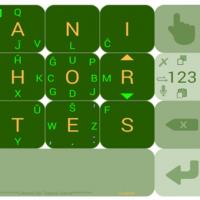Aportes: 14
Idioma: English
theFIZZYnator (Mostrar perfil) 6 de septiembre de 2015 12:06:10
Have you heard about the Dvorak keyboard layout? It is an ergonomic keyboard layout designed for touch-typing to replace the QWERTY layout, a relic from the typewriter era. It is fine-tuned for quick English typing, but can prove useful for other languages with little to no modification; I personally use Dvorak with Japanese, and while it took me a minute or two reconfiguring the converter to interpret ce and ci as ke and ki as opposed to se and si, after that was done, typing Japanese in Dvorak was lightning-fast.
' , . P Y F G C R L /A better representation can be seen on https://upload.wikimedia.org/wikipedia/commons/thu...
A O E U I D H T N S -
; Q J K X B M W V Z
The layout itself looks like this. It has the most common letters in the middle row (called the home row), which allows for quick access of those characters because the fingers are to be located there at rest. Less often occurring characters are placed farther out to make them harder to reach than more-used ones. All the vowels are placed under the left hand, which alternates with the consonants under the right hand when you type.
I am a long-time user of, and a 90WPM typist on the Dvorak keyboard, and a general nerd when it comes to keyboard layouts. So naturally, I was quite disappointed that there wasn't really a Dvorak-like keyboard meant for fast Esperanta typing. And honestly, it's quite overdue; Esperanto has spread all over the world, far more than any other conlang could dream of, and there are even some native Esperantists.
So I made a Dvorak for Esperanto myself:
Ŝ , . J P F G M R L /A better representation can be seen on http://i.imgur.com/W0JdIkU.png or as attached file
A O E U I D K T N S -
Z Ĉ Ŭ Ĵ Ĥ B C Ĝ V H
I moved around some letters according to a letter frequency table in Esperanto. The letter K occurred often in Esperanto, but the letter H rarely showed up, so K occupies the space of H in the original Dvorak, while H is pushed outward to where Z originally was. C and M are also switched because M appears more than C in Esperanto, as opposed to in English. The J was moved up to make it easier and more comfortable to type "-ajn" and "-ojn", while P was pushed outward from its original position to where Y was.
The letters in green in the image are accessible via AltGr or another deadkey. Pressing that key while also pressing AltGr yields the letters not commonly used in Esperanto, and also the quotation marks that have been exiled by Ŝ.
So, what do you think about this? You can test it out using DvorakJ, the Windows Keyboard Layout Creator, or anything else that lets you configure your own keyboard layout. I cannot link anywhere from Lernu Forum, but you can find information about them online.
Bruso (Mostrar perfil) 6 de septiembre de 2015 12:34:39
Alkanadi (Mostrar perfil) 6 de septiembre de 2015 13:38:26
Bruso:The problem is that people don't keyboard solely or almost solely in Esperanto, and would therefore have to change completely when typing in their primary language.I think that it will re-map the keys when you switch to Esperanto. So your English keyboard will remain the same.
Unless the idea is to change the English keyboard to the Dvorak.
jagr2808 (Mostrar perfil) 6 de septiembre de 2015 13:53:34
Alkanadi:but swapping back and forth with two different keyboards is basicaly impossible.Bruso:The problem is that people don't keyboard solely or almost solely in Esperanto, and would therefore have to change completely when typing in their primary language.I think that it will re-map the keys when you switch to Esperanto. So your English keyboard will remain the same.
Unless the idea is to change the English keyboard to the Dvorak.
Alkanadi (Mostrar perfil) 6 de septiembre de 2015 16:07:01
jagr2808:I hit ctrl shift to change keyboard layouts. I swap back and forth between Esperanto and English. If you download a keyboard that is mapped with the Dvorak Eperanto keys, then I think you just just keep switching back and forth.Alkanadi:but swapping back and forth with two different keyboards is basicaly impossible.Bruso:The problem is that people don't keyboard solely or almost solely in Esperanto, and would therefore have to change completely when typing in their primary language.I think that it will re-map the keys when you switch to Esperanto. So your English keyboard will remain the same.
Unless the idea is to change the English keyboard to the Dvorak.
makis (Mostrar perfil) 7 de septiembre de 2015 00:31:40
Alkanadi (Mostrar perfil) 7 de septiembre de 2015 07:06:22
Urho (Mostrar perfil) 7 de septiembre de 2015 07:37:15
Alkanadi:Off topic: has anyone tried the colemak keyboard. I heard that it is by far the best.Here is a link: http://colemak.com/

Urho (Mostrar perfil) 8 de septiembre de 2015 19:17:23
' , . P Y F G C R L / =Here is my suggestion:
A O E U I D H T N S - \
` ; Q J K X B M W V Z
, + g => ĝ
, + c => ĉ
, + e => ĵ (or , + j => ĵ)
, + u => ŭ
, + x => ĥ
, + s => ŝ
, + , => , || (x,x) a comma (,) without a space
, + i => j
, + w => š
, + v => č
, + z => ž
So the comma (,) is a dead key. — This keyboard really works on Mac OS X, but I use ÅUIOGX keyboad (in Finnish: ÅUIOGX-näppäimistö).
See also_ _ _
Updated: 2015-09-11
deltasalmon (Mostrar perfil) 9 de septiembre de 2015 15:29:02
Alkanadi:Off topic: has anyone tried the colemak keyboard. I heard that it is by far the best.I don't think it's the best as much as an easier alternative to use if you're used to a QWERTY layout.
I can't say from personal experience though. I learned to touch type in 7th grade on a QWERTY keyboard and changed over to Dvorak in college. Haven't gone back to QWERTY since.






